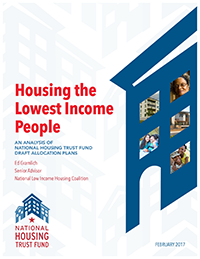 States must prepare national Housing Trust Fund (HTF) Allocation Plans each year showing how they intend to distribute HTF funds. In a new report, Housing the Lowest Income People: An Analysis of National Housing Trust Fund Draft Allocation Plans, NLIHC summarized the key features in the 51 draft HTF Allocation Plans the states and the District of Columbia were required to present for public comment prior to submission to HUD for approval. Highlights of the report include:
States must prepare national Housing Trust Fund (HTF) Allocation Plans each year showing how they intend to distribute HTF funds. In a new report, Housing the Lowest Income People: An Analysis of National Housing Trust Fund Draft Allocation Plans, NLIHC summarized the key features in the 51 draft HTF Allocation Plans the states and the District of Columbia were required to present for public comment prior to submission to HUD for approval. Highlights of the report include:
Type of HTF Project: All but two states would limit HTF assistance to rental projects; Pennsylvania and Rhode Island would consider homeowner activities. Fifteen states would use HTF for new construction and/or rehabilitation, six would support only new construction, and two mentioned only rehabilitation. Twenty-seven listed new construction, rehabilitation, and preservation as possible HTF activities; of these, four preferred preservation.
Estimated Number of HTF-Assisted Units: Thirty-two states estimated assisting a combined 995 rental units with HTF resources. Other states did not estimate the number of units assisted.
Target Populations: Thirty-seven states and the District of Columbia would target, prefer, or award points to projects serving target populations such as people who are homeless or at risk of homelessness, people with disabilities, domestic violence victims, youth leaving foster care, people transitioning out of incarceration, and veterans.
Merit of a Project: One of six statutory priority factors a state must consider when selecting a project is its “merit.” Among meritorious factors mentioned were environmental (17 states) and transit-related (11 states) features, neighborhood impact (10 states), and proximity to essential services (8 states).
Length of Affordability: One of six statutory priority factors a state must consider when selecting a project is how long rents will remain affordable. The rule requires a 30-year minimum. Twenty-one states would require or give priority to proposals with longer affordability periods.
Geographic Diversity: Sixteen states indicated geographic preferences. Four focused on rural areas, another three included rural areas with other priorities, and three specifically mentioned tribal areas.
Affirmatively Furthering Fair Housing: Twenty-eight states went beyond boiler-plate references to the statutory obligation to affirmatively furthering fair housing (AFFH). For example, eight would prioritize projects with AFFH features, and seven would offer competitive points to projects addressing AFFH.
Leveraging: One of six statutory priority factors a state must consider when selecting a project is the use of other funding sources. Twenty-three states discussed specific non-federal or other federal sources that HTF funds would leverage.
Using HTF with LIHTC, HOME, or Other State Programs: Related to leveraging, 32 states described operating their HTF program in conjunction with their Low Income Housing Tax Credit (LIHTC), HOME, or state programs. Most intended to use the applications and processes already used for LIHTC, HOME, or state programs.
Mixed-Income Properties: Also related to leveraging is occupancy of HTF-assisted properties by households with various income levels. Twelve states specifically referred to “mixed-income” projects.
The full report, Housing the Lowest Income People: An Analysis of National Housing Trust Fund Draft Allocation Plans, and 12 appendices providing state-specific details are at: http://bit.ly/2nfegq1
More information about the HTF is at: http://nlihc.org/issues/nhtf
